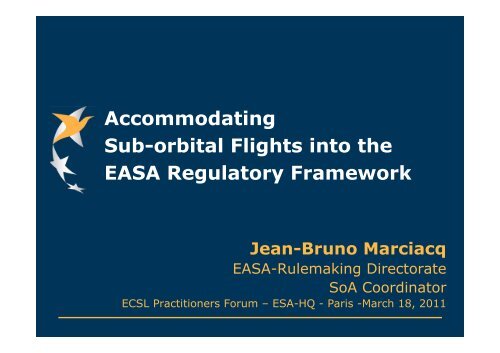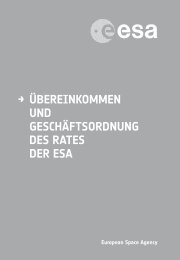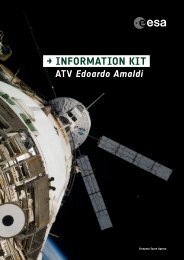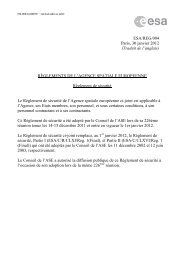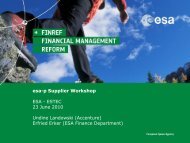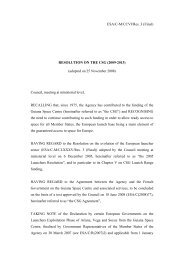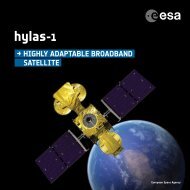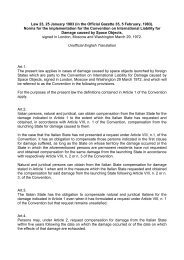Accommodating Sub-orbital Flights into the EASA Regulatory ... - ESA
Accommodating Sub-orbital Flights into the EASA Regulatory ... - ESA
Accommodating Sub-orbital Flights into the EASA Regulatory ... - ESA
You also want an ePaper? Increase the reach of your titles
YUMPU automatically turns print PDFs into web optimized ePapers that Google loves.
<strong>Accommodating</strong><br />
<strong>Sub</strong>-<strong>orbital</strong> <strong>Flights</strong> <strong>into</strong> <strong>the</strong><br />
<strong>EASA</strong> <strong>Regulatory</strong> Framework<br />
Jean-Bruno Marciacq<br />
<strong>EASA</strong>-Rulemaking Directorate<br />
SoA Coordinator<br />
ECSL Practitioners Forum – <strong>ESA</strong>-HQ - Paris -March 18, 2011
How would <strong>Sub</strong>-Orbital <strong>Flights</strong> fit <strong>into</strong><br />
<strong>the</strong> <strong>EASA</strong> <strong>Regulatory</strong> Framework?
European Aviation Safety Agency<br />
Contents<br />
I. The institutional and regulatory<br />
framework<br />
II. <strong>Sub</strong>-Orbital Aeroplanes vs. present<br />
<strong>EASA</strong> Regulations<br />
III. Proposed <strong>Regulatory</strong> approach<br />
IV. Conclusions<br />
Slide 3
European Aviation Safety Agency<br />
Slide 4
European Aviation Safety Agency<br />
I. The institutional and regulatory<br />
framework<br />
Slide 5
European Aviation Safety Agency<br />
European Union (EU) Agency, established in 2003<br />
Legal personality<br />
Independence<br />
Autonomy<br />
Vision:<br />
EU citizens should benefit from <strong>the</strong> safest and <strong>the</strong><br />
most environmentally-friendly civil aviation system in<br />
<strong>the</strong> world.<br />
Mission:<br />
Institutional framework<br />
Non-involved public<br />
Crews<br />
Paying passengers<br />
Promote <strong>the</strong> highest & uniform standards of civil<br />
aviation safety and environmental protection in Europe<br />
and worldwide.<br />
Slide 6
European Aviation Safety Agency<br />
The regulatory framework<br />
Regulation<br />
Initial 1592/2002/EC<br />
1 st ext. 216/2008/EC<br />
2 nd ext. 1108/2009/EC<br />
Competence<br />
Airworthiness<br />
Environmental Compatibility<br />
+ Flight Crew Licensing<br />
Operation of Aircraft<br />
Safety of 3rd country aircraft<br />
+ Safety of Aerodromes<br />
and ATM/ANS<br />
Slide 7
European Aviation Safety Agency<br />
1 st Layer: The Basic Regulation<br />
The Parliament and <strong>the</strong> Council define <strong>the</strong> Scope of<br />
Powers transferred from <strong>the</strong> Member States to <strong>the</strong> EU<br />
They adopt <strong>the</strong> Essential Requirements (ERs)<br />
specifying <strong>the</strong> safety objectives to be met<br />
Basic Regulation:<br />
Regulation (EC) 1592/2002 of 15 July 2002<br />
Superseded by:<br />
Regulation (EC) 216/2008<br />
of 20 February 2008<br />
Amended by:<br />
Regulation (EC) 1108/2009 of 21 Oct 2009<br />
Annex I : ERs for Airworthiness<br />
Annex II : Excluded Aircraft<br />
Annex III: ERs for pilot licensing<br />
Annex IV: ERs for air operations<br />
Annex V: Criteria for qualified<br />
entities<br />
Annex Va: ERs for Aerodromes<br />
Annex Vb: ERs for ATM/ANS<br />
Slide 8
European Aviation Safety Agency<br />
2 nd Layer: Implementing Rules,<br />
e.g. for airworthiness<br />
The Commission adopts measures for implementing<br />
<strong>the</strong> Essential Requirements<br />
Regulation (EC) 1702/2003 on Airworthiness<br />
and Environmental Certification<br />
Annex (Part 21)<br />
Section A: Application<br />
Requirements<br />
Section B: Procedures for<br />
Competent Authorities<br />
Appendices: <strong>EASA</strong><br />
forms<br />
Legally binding<br />
Directly applicable by EU persons<br />
Processes (no technical details)<br />
Responsibilities and privileges<br />
Regulation (EC) 2042/2003<br />
on Continuing Airworthiness<br />
Annex I (Part-M):<br />
Continuing Airworthiness<br />
Requirements<br />
Annex II (Part-145):<br />
Maintenance<br />
Organisation Approvals<br />
Annex III (Part-66):<br />
AML<br />
Annex IV (Part-147):<br />
Training Organisation<br />
Requirements<br />
Section A: Technical<br />
Requirements<br />
Section B: Administrative<br />
Procedures<br />
Appendices: <strong>EASA</strong><br />
forms<br />
Slide 9
European Aviation Safety Agency<br />
3 rd Layer: <strong>the</strong> Agency’s soft law,<br />
e.g. for airworthiness<br />
The Agency adopts non binding specifications for<br />
implementing <strong>the</strong> essential requirements,<br />
To allow for tailored flexibility, where necessary.<br />
Guidance<br />
Material<br />
Part 21<br />
Special<br />
Conditions or<br />
alternative<br />
AMCs possible<br />
AMC 20<br />
AMC 21<br />
CS 25<br />
CS 34<br />
CS 36<br />
CS E<br />
CS P<br />
CS APU<br />
Certification<br />
Specifications<br />
CS AWO<br />
CS ETSO<br />
CS Definitions<br />
CS 22<br />
CS 23<br />
CS 27<br />
CS 29<br />
CS VLA<br />
CS VLR<br />
AMC &<br />
Guidance<br />
Material<br />
Parts M, 145,<br />
66, 147<br />
Slide 10
European Aviation Safety Agency<br />
New domains<br />
More implementing rules to come for:<br />
Flight crew licensing<br />
Air operations by 04/2012<br />
Authorisation of third<br />
country operators (TCO)<br />
Safety of ATM/ANS<br />
(including Satellite SPs) by 06/2011<br />
ATCO licensing<br />
Safety of aerodromes by 12/2013<br />
FCL and OPS of UAS by 12/2016<br />
Slide 11
European Aviation Safety Agency<br />
II. <strong>Sub</strong>-Orbital Aeroplanes<br />
within <strong>EASA</strong> Basic Regulation<br />
Slide 12
European Aviation Safety Agency<br />
<strong>EASA</strong> competence: only for aircraft<br />
Aircraft (definition in ICAO Ann. 6 & 8):<br />
“Any machine that can derive support in <strong>the</strong> atmosphere<br />
from <strong>the</strong> reactions of <strong>the</strong> air o<strong>the</strong>r than <strong>the</strong> reactions of<br />
<strong>the</strong> air against <strong>the</strong> earth’s surface”<br />
Machines able to fly in <strong>the</strong> atmosphere sustained by wings<br />
are aircraft<br />
Aircraft are in <strong>the</strong> competence of <strong>EASA</strong><br />
Rockets are in <strong>the</strong> competence of Member States<br />
Aeroplanes limits <strong>the</strong> scope to fixed-wings aircraft<br />
<strong>Sub</strong>-<strong>orbital</strong>: performing most of <strong>the</strong>ir flight in <strong>the</strong><br />
atmosphere, only temporarily entering outer space<br />
<strong>Sub</strong>-Orbital Aeroplanes (SoA) are under our scope and<br />
need to be certified for airworthiness as well as to be<br />
operated according to aviation rules<br />
Slide 13
European Aviation Safety Agency<br />
All aircraft are in <strong>the</strong> <strong>EASA</strong> competence<br />
except…<br />
…those listed in Annex II of <strong>the</strong> Basic Regulation:<br />
Historic aircraft<br />
Research, experimental or scientific aircraft<br />
Amateur built<br />
Former military aircraft<br />
« light » aircraft (e.g. MTOM < 450 Kg for a two<br />
seater aeroplane)<br />
« light » gliders (MEM < 100 Kg)<br />
« replicas »<br />
And those used for State missions<br />
Slide 14
European Aviation Safety Agency<br />
III. <strong>Regulatory</strong> Approach<br />
Slide 15
European Aviation Safety Agency<br />
Proposed <strong>Regulatory</strong> Approach<br />
(SoA Airworthiness)<br />
Limited Certification :<br />
Restricted Type Certificate (RTC)<br />
Restricted Certificate of Airworthiness (RCofA)<br />
Organisation Approvals / Certificates:<br />
Design (DOA)<br />
Production (POA)<br />
Continuous Airworthiness Management<br />
(CAMOA)<br />
Maintenance (MOA)<br />
Slide 16
European Aviation Safety Agency<br />
Proposed <strong>Regulatory</strong> Approach (Special<br />
conditions for SoA airworthiness)<br />
CS-23 or CS-25 (TBD) and CS-E<br />
+ Special Conditions and Equivalent Safety Findings<br />
Classification depending on weight/fuel trade-off<br />
Safety not to be jeopardized by larger amount of fuel<br />
needed to accommodate required design features<br />
CRIs and associated ELoS to be developed for:<br />
Propulsion<br />
Fuel<br />
ECLSS<br />
Containment of all fluids in weightlessness<br />
IVA safety requirements<br />
…<br />
TBD depending on proposed designs and operations<br />
Slide 17
European Aviation Safety Agency<br />
Proposed <strong>Regulatory</strong> Approach<br />
(SoA operations)<br />
Organisation Approvals:<br />
Air Operator Certificate (AOC) for Commercial OPS<br />
Operations:<br />
EU-OPS/ <strong>EASA</strong>-OPS with flexibility (Art. 14 BR) for EU<br />
operators<br />
<strong>EASA</strong> Authorization to non-EU operators flying to/from EU<br />
National rules for operations outside EU (no <strong>EASA</strong> role)<br />
Aerodromes and ATM/ANS:<br />
Special Conditions to be developed for “Spaceports”<br />
Procedures to be developed for Air/Space Traffic<br />
Management<br />
Flight Crew Licensing and PAX Safety:<br />
Part-FCL with exemptions could work (Flight Test rating?)<br />
PAX Safety rules to be considered<br />
Slide 18
European Aviation Safety Agency<br />
IV. Conclusions<br />
Slide 19
European Aviation Safety Agency<br />
Conclusions (1/3)<br />
<strong>EASA</strong> is getting ready to accept first applications<br />
for <strong>Sub</strong>-Orbital Aeroplanes (SoA):<br />
<strong>EASA</strong> ISC decision 8 th of July 2008 to launch exploratory work<br />
Internal Working Group with experts on specific subjects<br />
Official presentations + papers:<br />
1. IAASS 3 rd Conference, Rome 21-23 October 2008<br />
2. IAASS 4 th Conference, Huntsville 19-21 May 2010<br />
3. IAC 61 st Conference, Prague 27 Sept-1 October 2010<br />
4. FAA-AST 14 th Conference, Washington DC 09-10 February 2011<br />
HoD Decision November 2010 to prepare rulemaking task<br />
Certification basis would be Existing Requirements,<br />
complemented with Specific Requirements (TBD)<br />
Cooperative research framework proposed for first applications, in order<br />
to jointly define detailed Certification Specifications<br />
SoA Policy to be issued before end of 2012<br />
Letters sent to organisations and NAAs/NSAs on request<br />
Regulations would follow in <strong>the</strong> longer term<br />
Based on feedback and return of experience<br />
Slide 20
European Aviation Safety Agency<br />
Proposed Schedule:<br />
Decision to prepare RM Task<br />
Paper to ISC<br />
Pre-RIA<br />
ToR<br />
Insertion <strong>into</strong> RM programme<br />
1 st Public Workshop<br />
NPA<br />
Deadline for comments<br />
CRD<br />
2 nd Public Workshop<br />
Decision/publication<br />
Directors<br />
Internal<br />
AGNA / SSCC<br />
Internal<br />
MB<br />
<strong>EASA</strong><br />
Publication<br />
<strong>EASA</strong><br />
website<br />
Publication<br />
<strong>EASA</strong><br />
ED<br />
Nov 2010<br />
February 2011<br />
22-24 March 2011<br />
April 2011<br />
July 2011<br />
November 2011<br />
January 2012<br />
April 2012<br />
September 2012<br />
September 2012<br />
October 2012
European Aviation Safety Agency<br />
Conclusions (2/3)<br />
Designers and (EU & TCO) Operators would<br />
have to be approved prior to 1 st commercial<br />
flight, including:<br />
Operations<br />
Flight Crew Licensing / PAX Safety<br />
Continued Airworthiness /Maintenance<br />
Aerodromes<br />
Permits to Fly would only be granted for Test<br />
<strong>Flights</strong><br />
Annex II Aircraft would be under responsibility of<br />
Individual Member States<br />
Restricted Type Certificate is preferred for<br />
Commercial <strong>Flights</strong><br />
Slide 22
European Aviation Safety Agency<br />
Conclusions (3/3)<br />
Cooperation with Member States (MS) and o<strong>the</strong>r<br />
relevant stakeholders is deemed necessary<br />
in order to cover <strong>the</strong> full scope of approvals for <strong>Sub</strong><strong>orbital</strong><br />
Aeroplanes<br />
Possible future market extension to outer<br />
space commercial air transport (A to B):<br />
deeper legal implications with MS<br />
global harmonisation through ICAO<br />
technical and regulatory cooperation needed with spaceexperienced<br />
entities<br />
such as <strong>ESA</strong>, NSAs, NASA and FAA-AST<br />
<strong>EASA</strong> is looking forward to cooperating with<br />
o<strong>the</strong>r key players in <strong>the</strong> field such as Designers,<br />
Operators, MS, ICAO, NAAs and NSAs<br />
Slide 23
European Aviation Safety Agency<br />
Thank you for your attention!<br />
Questions ?
European Aviation Safety Agency<br />
Do not hesitate to contact us<br />
for any fur<strong>the</strong>r information<br />
jean-bruno.marciacq@easa.europa.eu<br />
Slide 25


